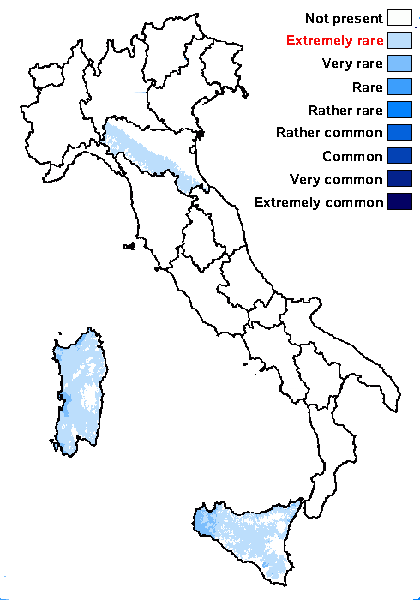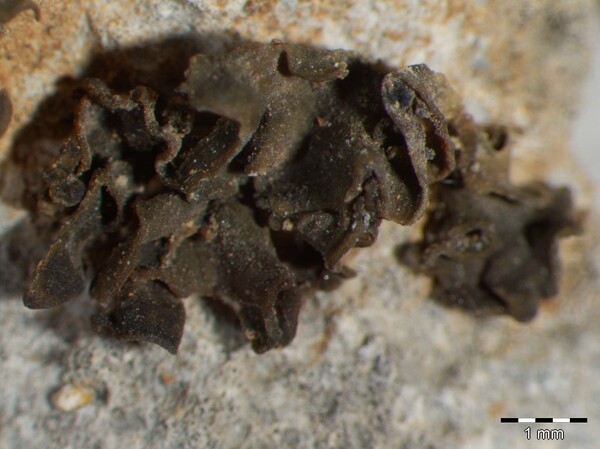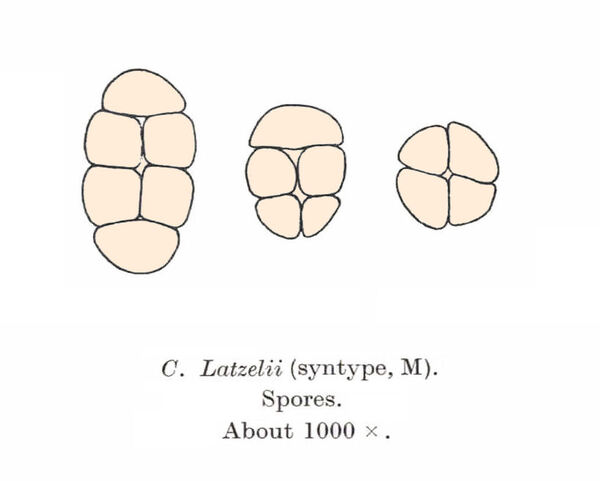Lathagrium latzelii (Zahlbr.) Otálora, P.M. Jørg. & Wedin
Fungal Divers., 64, 1: 287, 2013. Basionym: Collema latzelii Zahlbr. - Österr. bot. Z., 59: 493, 1909.
Synonyms:
Distribution: N - Emil (Valcuvia & Delucchi 2001, Fariselli & al. 2020). C - Sar. S - Si (Nimis & al. 1994).
Description: Thallus foliose, homoiomerous, gelatinous and 50-120(-200) μm thick when wet, dark olive-green to black, rather firmly attached, deeply lobed, forming orbicular to irregular 1.5-3(-6) cm wide rosettes. Lobes 1-3(-5) mm wide, radiating, repeatedly branched, contiguous or often overlapping, with ascending, undulate, not swollen margins, sometimes with initially globose, then flattened isidioid outgrowths; lower surface smooth, usually paler than upper surface, with scattered white hapters. Apothecia lecanorine, 0.3-0.8(-1) mm across, sessile, strongly constricted at base and sometimes substipitate, with a slightly concave to flat, brown disc, a thin, smooth, finally often excluded thalline margin and often a distinct parathecial ring. Thalline exciple ecorticate; proper exciple euparaplectenchymatous, 15-40 μm wide laterally, (25-)40-70 μm wide at base; epithecium brown; hymenium colourless, 90-130(-190) μm high, I+ blue; paraphyses simple or sparingly branched in upper part, 1.5-2 μm thick at mid-level, the apical cells swollen, at least 4 μm wide; hypothecium yellowish brown, I+ blue. Asci 8-spored, cylindrical-clavate, the apex strongly thickened, the apical dome K/I+ pale blue, with a downwardly projecting K/I+ deep blue tubular structure. Ascospores submuriform, with 1-3 transverse septa and 1 longitudinal septum (4-6 cells visible in optical view), hyaline, oval to subglobose or cuboid, (12-)15-22(-26) x (8-)9-12(-13) μm. Pycnidia frequent, marginal or laminal, paler than thallus. Conidia bacilliform, thickened at apices, 4.5-5 x c. 1.5 μm. Photobiont cyanobacterial (Nostoc, the cells in long chains). Spot tests: all negative. Chemistry: without lichen substances. Note: a mild-temperate species found on steeply inclined seepage tracks of calciferous rocks, sometimes of serpentine, usually at low elevations; overlooked, perhaps more widespread in Southern Italy, but certainly not common.
Growth form: Foliose, narrow lobed
Substrata: rocks
Photobiont: cyanobacteria, filamentous (e.g. Nostoc, Scytonema)
Reproductive strategy: mainly sexual
Most common in areas with a humid-warm climate (e.g. most of Tyrrenian Italy)
On otherwise dry surfaces with short periods of water seepage after rain
Commonnes-rarity: (info)
Alpine belt: absent
Subalpine belt: absent
Oromediterranean belt: absent
Montane belt: absent
Submediterranean belt: extremely rare
Padanian area: absent
Humid submediterranean belt: extremely rare
Humid mediterranean belt: very rare
Dry mediterranean belt: absent

Predictive model
Growth form: Foliose, narrow lobed
Substrata: rocks
Photobiont: cyanobacteria, filamentous (e.g. Nostoc, Scytonema)
Reproductive strategy: mainly sexual
Most common in areas with a humid-warm climate (e.g. most of Tyrrenian Italy)
On otherwise dry surfaces with short periods of water seepage after rain
Commonnes-rarity: (info)
Alpine belt: absent
Subalpine belt: absent
Oromediterranean belt: absent
Montane belt: absent
Submediterranean belt: extremely rare
Padanian area: absent
Humid submediterranean belt: extremely rare
Humid mediterranean belt: very rare
Dry mediterranean belt: absent

Predictive model
 INDEX FUNGORUM
INDEX FUNGORUM
 GBIF
GBIF




